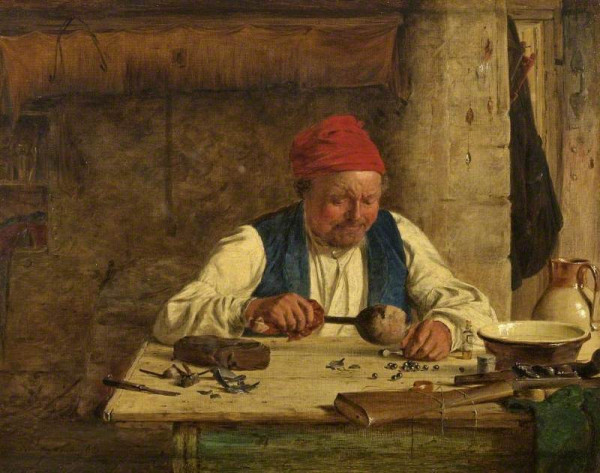‘Making Pills for the Saxons’ (1868) by Erskine Nicol (1825-1904)
I must admit to some confusion, on my part, over this painting – a situation that has been with me for years. It started with my discovering this work in the Picture Store at Cheltenham Art Gallery and Museum soon after I took up post in 1973. I now realise that titles given to paintings can be misleading – none more so than with this painting. Is this really a painting of an ancient Saxon workman? Did Saxons have pills? What is the point in painting someone making pills? I relegated it in my mind to the shelf ‘of no interest.’. Having now returned to Cheltenham, after many years, I have become, hopefully, a little wiser and with time to re-evaluate my original assessment.
On looking at the painting again, with a more tolerant and observant eye, I found details which I had overlooked previously. It was the sight of a shot-gun and a pistol lying on the table which caught my attention. Whilst they are ‘historic’ items they do not seem ‘ancient’ – in fact they seemed to be probably of the period in which the artist lived and produced this work. Continuing my exploration of the work I noticed there appeared to be ball-bearings, or something similar, on the table. There is also a small bottle of some yellowish liquid and some smallish pieces of paper or card. Armed with this information I then tackled the enigma of the title ‘Making Pills for the Saxons’ – but how? Perhaps I should start with that word ‘Saxons’ – does it really refer to a person from Saxony or an historic Saxon invader? No obvious way forward on this line of attack. As a long shot I decided to concentrate on the firearms – the shot-gun and the pistol. I know very little about firearms but the pistol did seem to be of early nineteenth century vintage. As to shot-guns, I only knew about them from living in rural Oxfordshire where ‘shoots’ were a regular part of everyday life, but I had never handled one. The one in the painting did seem rather ‘modern’, perhaps a clue might be here. I realised that the small things like ball-bearings, plus the other items, could be the ingredients for ‘shot’ – I was aware of both shot and cartridge cases. It was clearly time to learn more about firearms of the nineteenth century. After trawling through endless, and often boring, treatises on firearms and dealers lists I came across a reference which gave me a clue. In the early part of the nineteenth century several attempts were made, in Europe and in Britain, to improve the performance of the traditional flintlock firearm. As shooting ‘game’ became ever more fashionable the disadvantages of firing with a flintlock was energetically voiced – particularly the fact that it’s noise, plus flash and smoke, as it fired alerted the game, bird or beast, who immediately fled from the scene. Experiments began to be made into possible ways of improving percussion – and one successful alternative used a pin-fired mechanism which activated a chemical concoction which ‘fired’ a pellet or pellets. One enterprising manufacturer decided to go ahead with this new firearm – and the name of the firm was ‘Saxon’! Here at last appeared to be the answer to my questions about the subject matter of this painting – here was a game-keeper making up the cartridges containing the explosive and the bullets ready to be used by people using the modern shot-gun similar to that lying on the table. Or have I got it terribly wrong? Like Millais and ‘Bubbles’ advertising Pear’s Soap this might be an advertisement for the guns made by the firm ‘Saxon’.

